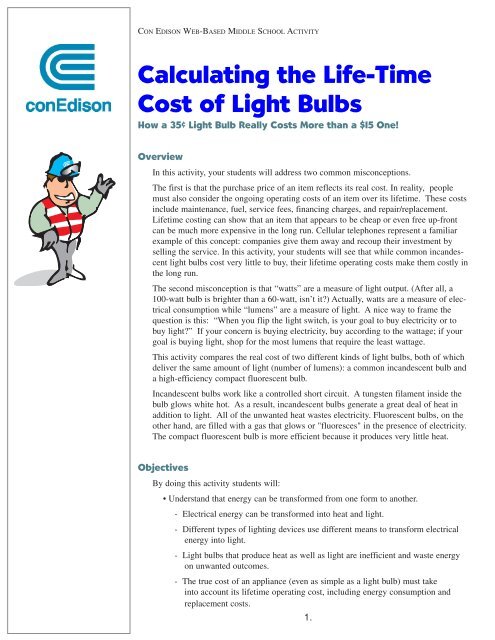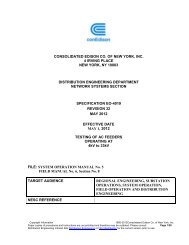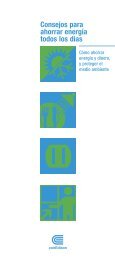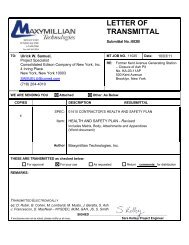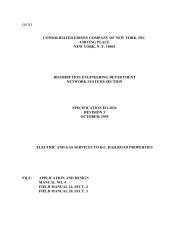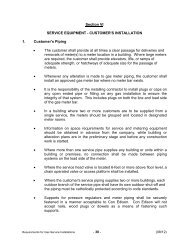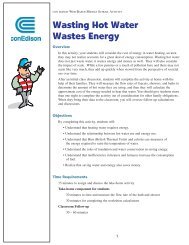Calculating the Life-Time Cost of Light Bulbs - Con Edison
Calculating the Life-Time Cost of Light Bulbs - Con Edison
Calculating the Life-Time Cost of Light Bulbs - Con Edison
You also want an ePaper? Increase the reach of your titles
YUMPU automatically turns print PDFs into web optimized ePapers that Google loves.
CON EDISON WEB-BASED MIDDLE SCHOOL ACTIVITY<br />
<strong>Calculating</strong> <strong>the</strong> <strong>Life</strong>-<strong>Time</strong><br />
<strong>Cost</strong> <strong>of</strong> <strong>Light</strong> <strong>Bulbs</strong><br />
How a 35¢ <strong>Light</strong> Bulb Really <strong>Cost</strong>s More than a $15 One!<br />
Overview<br />
In this activity, your students will address two common misconceptions.<br />
The first is that <strong>the</strong> purchase price <strong>of</strong> an item reflects its real cost. In reality, people<br />
must also consider <strong>the</strong> ongoing operating costs <strong>of</strong> an item over its lifetime. These costs<br />
include maintenance, fuel, service fees, financing charges, and repair/replacement.<br />
<strong>Life</strong>time costing can show that an item that appears to be cheap or even free up-front<br />
can be much more expensive in <strong>the</strong> long run. Cellular telephones represent a familiar<br />
example <strong>of</strong> this concept: companies give <strong>the</strong>m away and recoup <strong>the</strong>ir investment by<br />
selling <strong>the</strong> service. In this activity, your students will see that while common incandescent<br />
light bulbs cost very little to buy, <strong>the</strong>ir lifetime operating costs make <strong>the</strong>m costly in<br />
<strong>the</strong> long run.<br />
The second misconception is that “watts” are a measure <strong>of</strong> light output. (After all, a<br />
100-watt bulb is brighter than a 60-watt, isn’t it?) Actually, watts are a measure <strong>of</strong> electrical<br />
consumption while “lumens” are a measure <strong>of</strong> light. A nice way to frame <strong>the</strong><br />
question is this: “When you flip <strong>the</strong> light switch, is your goal to buy electricity or to<br />
buy light?” If your concern is buying electricity, buy according to <strong>the</strong> wattage; if your<br />
goal is buying light, shop for <strong>the</strong> most lumens that require <strong>the</strong> least wattage.<br />
This activity compares <strong>the</strong> real cost <strong>of</strong> two different kinds <strong>of</strong> light bulbs, both <strong>of</strong> which<br />
deliver <strong>the</strong> same amount <strong>of</strong> light (number <strong>of</strong> lumens): a common incandescent bulb and<br />
a high-efficiency compact fluorescent bulb.<br />
Incandescent bulbs work like a controlled short circuit. A tungsten filament inside <strong>the</strong><br />
bulb glows white hot. As a result, incandescent bulbs generate a great deal <strong>of</strong> heat in<br />
addition to light. All <strong>of</strong> <strong>the</strong> unwanted heat wastes electricity. Fluorescent bulbs, on <strong>the</strong><br />
o<strong>the</strong>r hand, are filled with a gas that glows or "fluoresces" in <strong>the</strong> presence <strong>of</strong> electricity.<br />
The compact fluorescent bulb is more efficient because it produces very little heat.<br />
Objectives<br />
By doing this activity students will:<br />
• Understand that energy can be transformed from one form to ano<strong>the</strong>r.<br />
- Electrical energy can be transformed into heat and light.<br />
- Different types <strong>of</strong> lighting devices use different means to transform electrical<br />
energy into light.<br />
- <strong>Light</strong> bulbs that produce heat as well as light are inefficient and waste energy<br />
on unwanted outcomes.<br />
- The true cost <strong>of</strong> an appliance (even as simple as a light bulb) must take<br />
into account its lifetime operating cost, including energy consumption and<br />
replacement costs.<br />
1.
<strong>Time</strong> Requirements<br />
20 minutes for opening discussion and review <strong>of</strong> <strong>the</strong> math<br />
30 minutes for completing <strong>the</strong> math worksheet (ei<strong>the</strong>r in class or at home)<br />
30 minutes for follow-up discussion<br />
Materials<br />
Student worksheet<br />
For Optional Demonstration<br />
Two lamps<br />
100-watt incandescent light bulb<br />
25-watt high-efficiency compact fluorescent light bulb<br />
Procedure<br />
NOTE: If you use a 100-watt incandescent bulb, use a 25-watt compact<br />
fluorescent; for a 75-watt incandescent, use an 18-watt high-efficiency compact<br />
fluorescent. Compact fluorescent bulbs generally emit <strong>the</strong> same light as an<br />
incandescent bulb that uses about four times more electricity. Unlike incandescent<br />
bulbs, though, fluorescent bulbs need a few minutes to “warm up” and<br />
shine at <strong>the</strong>ir full brightness.<br />
1. Preliminary discussion<br />
A. Open <strong>the</strong> discussion by asking a leading question: “Which is cheaper, a 35¢ light<br />
bulb or a $15 light bulb?”<br />
Lead <strong>the</strong> discussion by asking about all <strong>of</strong> <strong>the</strong> costs involved in operating an<br />
appliance in addition to <strong>the</strong> purchase price: operating cost, maintenance cost,<br />
cost <strong>of</strong> financing, replacement cost, and social/environmental costs, just to<br />
name <strong>the</strong> major ones.<br />
B. Ask your students to explain what <strong>the</strong>y know about <strong>the</strong> word “efficiency” so you<br />
can be sure <strong>the</strong>y know what it means.<br />
All work requires energy. When an operation is efficient, completing <strong>the</strong> work<br />
requires less energy than if it were inefficient. A boat with a pointed bow, for<br />
example, requires less energy to cut through <strong>the</strong> water than a boat with a flat<br />
bow; it is more efficient. Ask your students to think about examples <strong>of</strong><br />
efficiency in <strong>the</strong>ir own lives, such as techniques <strong>the</strong>y might have for memorizing<br />
vocabulary words.<br />
C. Ask your students what <strong>the</strong>y intend to be buying when <strong>the</strong>y flip <strong>the</strong> light switch.<br />
When <strong>the</strong>y answer “light” – duh! – ask if <strong>the</strong>y also realize <strong>the</strong>y are buying heat at<br />
<strong>the</strong> same time. Ask if any <strong>of</strong> <strong>the</strong>m have ever touched a burning light bulb, and<br />
have <strong>the</strong>m describe <strong>the</strong> experience.<br />
2.
Incandescent<br />
100-watt<br />
1,690 lumens<br />
35¢<br />
Fluorescent<br />
25-watt<br />
1,750 lumens<br />
$15<br />
D. Explain that not all light bulbs get as hot as o<strong>the</strong>r bulbs. When a bulb makes just<br />
light instead <strong>of</strong> light and heat, it is more efficient: <strong>the</strong> electricity is used for <strong>the</strong><br />
intended work ra<strong>the</strong>r than making an unwanted waste product. It does not have to<br />
waste electricity to make heat.<br />
The incandescent bulb creates light when electricity runs through <strong>the</strong> thin tungsten<br />
filament inside <strong>the</strong> bulb. The friction <strong>of</strong> <strong>the</strong> electrons running across <strong>the</strong><br />
thin wire produces intense radiant heat. Part <strong>of</strong> <strong>the</strong> electricity goes into making<br />
<strong>the</strong> light, and <strong>the</strong> rest goes into making <strong>the</strong> heat. It is “inefficient” because<br />
much <strong>of</strong> <strong>the</strong> electricity is wasted as unwanted heat instead <strong>of</strong> light.<br />
The fluorescent bulb, on <strong>the</strong> o<strong>the</strong>r hand, creates light when <strong>the</strong> electrons excite<br />
<strong>the</strong> gas molecules inside <strong>the</strong> bulb and cause it to glow, or fluoresce. It is “efficient”<br />
because very little <strong>of</strong> <strong>the</strong> electrical energy is converted to heat, so <strong>the</strong><br />
bulb uses less electricity to produce roughly <strong>the</strong> same amount <strong>of</strong> light.<br />
2. Math Activity<br />
Have <strong>the</strong> students complete <strong>the</strong> worksheet ei<strong>the</strong>r in class or as homework. Explain<br />
that <strong>the</strong> cost figures vary from store to store. These costs are based on <strong>the</strong> pricing<br />
at a major national chain. Students may work individually, in teams, or with adults<br />
at home.<br />
3. Homework<br />
Ask your students to examine <strong>the</strong> bulbs in <strong>the</strong>ir homes and see if <strong>the</strong>y have any<br />
fluorescent tubes or compact fluorescent bulb in addition to “halogen” lamps and<br />
conventional incandescent bulbs. Also ask <strong>the</strong>m to look for <strong>the</strong> wattage, <strong>the</strong><br />
expected life, and <strong>the</strong> lumens <strong>of</strong> any replacement bulbs <strong>the</strong>y might have at home.<br />
4. Closing discussion<br />
Lead a discussion about <strong>the</strong>ir findings. Their calculations will show that <strong>the</strong><br />
purchase price does not reflect <strong>the</strong> true cost <strong>of</strong> a light bulb at all. Ask what <strong>the</strong>y<br />
will think in <strong>the</strong> future when <strong>the</strong>y see two seemingly similar items in a store with<br />
widely different prices and how will <strong>the</strong>y try to analyze <strong>the</strong> difference.<br />
5. Follow-up<br />
Extenders<br />
Have your students prepare an advertising and public relations campaign designed<br />
to teach people about <strong>the</strong> relationship between purchase price and true price and to<br />
promote <strong>the</strong> use <strong>of</strong> efficient lighting equipment.<br />
1. Compare <strong>the</strong> life-cycle cost <strong>of</strong> a major appliance, such as a refrigerator, washing<br />
machine, clo<strong>the</strong>s dryer, dishwasher, or air conditioner. Visit an appliance store to<br />
ga<strong>the</strong>r information about <strong>the</strong> costs <strong>of</strong> efficient and inefficient models. Find out <strong>the</strong><br />
estimated life expectancy and energy use. Much <strong>of</strong> this information is located on an<br />
Energy Guide Label attached to each new appliance.<br />
Would paying more up front save customers money in <strong>the</strong> long run?<br />
3.
If so:<br />
- How long would <strong>the</strong>y have to use <strong>the</strong>ir appliance to “break even” on <strong>the</strong><br />
higher price if <strong>the</strong>y bought a more expensive but more efficient model?<br />
- How much money and energy would customers save over <strong>the</strong> expected life <strong>of</strong><br />
<strong>the</strong> appliance?<br />
Discussion Topics<br />
1. Why do energy efficient light bulbs and appliances <strong>of</strong>ten cost more than more<br />
inefficient models?<br />
Fewer people buy <strong>the</strong>m, and <strong>the</strong>y cost more to produce and to market. In fact,<br />
new technologies <strong>of</strong>ten cost more to buy than well-established technologies.<br />
2. In <strong>the</strong> summer, what is an additional disadvantage <strong>of</strong> a light bulb that produces<br />
unwanted heat?<br />
Incandescent bulbs generate heat, which increases <strong>the</strong> strain placed on air<br />
conditioners in <strong>the</strong> hot summer.<br />
Research Projects<br />
Examples <strong>of</strong> Ways to <strong>Con</strong>serve Energy<br />
• Buy energy-efficient light bulbs and appliances.<br />
• Turn <strong>of</strong>f light bulbs and o<strong>the</strong>r appliances when <strong>the</strong>y are not needed.<br />
• Raise <strong>the</strong> temperature <strong>of</strong> air conditioning to 78°F in summer.<br />
• Lower <strong>the</strong> temperature <strong>of</strong> heating to 68° in winter.<br />
• Carpool, walk, ride bikes, or take public transportation when possible.<br />
1. <strong>Con</strong>duct a “lighting audit” <strong>of</strong> your home<br />
1. How many incandescent light bulbs are in your home?<br />
____ # <strong>of</strong> incandescent bulbs<br />
2. Estimate <strong>the</strong> average number <strong>of</strong> hours per day that each one burns.<br />
____ hours per day per bulb<br />
3. How many kilowatt hours <strong>of</strong> electricity per day are you using for lighting<br />
with incandescent bulbs?<br />
____ kilowatt hours<br />
4. What is <strong>the</strong> cost <strong>of</strong> that electricity at $0.16 per kilowatt hour?<br />
____ dollars spent on electricity<br />
5. High-efficiency fluorescent bulbs use about one-fourth <strong>the</strong> amount <strong>of</strong><br />
electricity to produce <strong>the</strong> same light.<br />
4.
Review<br />
How much electricity would you save in one year if you used high-<br />
efficiency fluorescent bulbs?<br />
____ kilowatt hours savings with high-efficiency fluorescent bulbs<br />
How much money would you save?<br />
____ dollars savings with high-efficiency compact fluorescent bulbs.<br />
2. Do a similar “lighting audit” for your school, asking <strong>the</strong> maintenance department<br />
for help. Figure out how many lighting fixtures use incandescent lights that<br />
could be changed to high-efficiency florescent light bulbs. Estimate how long <strong>the</strong>y<br />
burn in a typical day and how much replacing <strong>the</strong>m would save in energy and<br />
money.<br />
1. What is <strong>the</strong> difference in <strong>the</strong> way an incandescent bulb and a florescent bulb<br />
produce light?<br />
An incandescent bulb has a tungsten wire that glows when electricity passes<br />
through it and heats it up. A florescent bulb contains a gas that glows when<br />
electricity passes through it.<br />
2. What do watts measure?<br />
Electrical consumption.<br />
3. What do lumens measure?<br />
<strong>Light</strong>.<br />
4. Why is an incandescent bulb said to be less efficient than a florescent bulb?<br />
It uses about 3/4 <strong>of</strong> its electrical consumption to make heat ra<strong>the</strong>r light, yet<br />
people use light bulbs for lighting, not heating.<br />
5. What does lifetime costing take into account in addition to purchase price?<br />
Maintenance, fuel (including electricity), parts (such as batteries), repairs,<br />
service fees, expected life span replacement cost.<br />
6. What are some o<strong>the</strong>r examples <strong>of</strong> equipment where on-going operating costs might<br />
make an item with a low purchase price more expensive to use.<br />
Refrigerators, air conditioners, washing machines, clo<strong>the</strong>s dryers,<br />
dishwashers, cars.<br />
5.
Worksheet Name: ___________________________<br />
<strong>Calculating</strong> <strong>the</strong> <strong>Life</strong>-<strong>Time</strong> <strong>Cost</strong> <strong>of</strong> <strong>Light</strong> <strong>Bulbs</strong><br />
NOTE: 1,000 watts burning for one hour equals one kilowatt hour, which is <strong>the</strong><br />
usual pricing unit for electricity. One kilowatt hour <strong>of</strong> electricity in New York<br />
City costs 16¢.<br />
100-watt Incandescent Bulb (1,690 lumens)<br />
<strong>Cost</strong> <strong>of</strong> one bulb ____35¢__<br />
<strong>Life</strong> expectancy <strong>of</strong> one bulb 1,000 hours<br />
# <strong>of</strong> bulbs needed to burn for 10,000 hours _________<br />
How much will you pay for all <strong>the</strong> bulbs you will need<br />
to burn for 10,000 hours? $________<br />
A 100-watt bulb must burn for how many hours to<br />
use one kilowatt <strong>of</strong> electricity? (1,000 ÷ 100) _____hours<br />
How many kilowatt-hours <strong>of</strong> electricity will you<br />
use in 10,000 hours <strong>of</strong> lighting <strong>the</strong> bulb?<br />
(10,000 ÷ number <strong>of</strong> hours per kilowatt) _____kWh<br />
How much will you spend on electricity in 10,000<br />
hours <strong>of</strong> operation? (Remember, electricity costs<br />
16¢ per kilowatt hour, so # kWh X $.16) $________<br />
If you add toge<strong>the</strong>r <strong>the</strong> cost <strong>of</strong> buying <strong>the</strong> bulbs and <strong>the</strong> cost<br />
<strong>of</strong> operating <strong>the</strong> bulbs, how much will you spend to burn <strong>the</strong><br />
100-watt incandescent bulb for 10,000 hours? $________<br />
25-watt Compact Fluorescent Bulb (1,750 lumens)<br />
<strong>Cost</strong> <strong>of</strong> one bulb ____$15__<br />
<strong>Life</strong> expectancy <strong>of</strong> one bulb 10,000 hours<br />
# <strong>of</strong> bulbs needed to burn for 10,000 hours _________<br />
How much will you pay for all <strong>the</strong> bulbs you will need<br />
to burn for 10,000 hours? $________<br />
A 25-watt bulb must burn for how many hours to use<br />
one kilowatt <strong>of</strong> electricity? (1,000 ÷ 25) _____hours<br />
How many kilowatt-hours <strong>of</strong> electricity will you use<br />
in 10,000 hours <strong>of</strong> lighting <strong>the</strong> bulb?<br />
(10,000 ÷ number <strong>of</strong> hours per kilowatt) _____kWh<br />
How much will you spend on electricity in<br />
10,000 hours <strong>of</strong> operation? (Remember, electricity costs<br />
16¢ per kilowatt hour, so # kWh X $.16). $________<br />
If you add toge<strong>the</strong>r <strong>the</strong> cost <strong>of</strong> buying <strong>the</strong> bulbs and <strong>the</strong> cost<br />
<strong>of</strong> operating <strong>the</strong> bulbs, how much will you spend to<br />
burn <strong>the</strong> 25-watt fluorescent bulb for 10,000 hours? $________<br />
<strong>Con</strong>clusion<br />
The ________________________ bulb is $_________ less expensive over its life than<br />
<strong>the</strong> ______________________ bulb.<br />
6.
Worksheet Answer Key<br />
<strong>Calculating</strong> <strong>the</strong> <strong>Life</strong>-<strong>Time</strong> <strong>Cost</strong> <strong>of</strong> <strong>Light</strong> <strong>Bulbs</strong><br />
NOTE: 1,000 watts burning for one hour equals one kilowatt hour, which is <strong>the</strong><br />
usual pricing unit for electricity. One kilowatt hour <strong>of</strong> electricity in Manhattan<br />
costs 16¢.<br />
100-watt Incandescent Bulb (1,690 lumens)<br />
<strong>Cost</strong> <strong>of</strong> one bulb ____35¢__<br />
<strong>Life</strong> expectancy <strong>of</strong> one bulb 1,000 hours<br />
# <strong>of</strong> bulbs needed to burn for 10,000 hours ___10____<br />
How much will you pay for all <strong>the</strong> bulbs you will need<br />
to burn for 10,000 hours? ___$3.50__<br />
A 100-watt bulb must burn for how many hours to<br />
use one kilowatt <strong>of</strong> electricity? (1,000 ÷ 100) _10 hours_<br />
How many kilowatt-hours <strong>of</strong> electricity will you<br />
use in 10,000 hours <strong>of</strong> lighting <strong>the</strong> bulb?<br />
(10,000 ÷ number <strong>of</strong> hours per kilowatt) _1,000 kWh<br />
How much will you spend on electricity in 10,000<br />
hours <strong>of</strong> operation? (Remember, electricity costs<br />
16¢ per kilowatt hour, so # kWh X $.16) _$160____<br />
If you add toge<strong>the</strong>r <strong>the</strong> cost <strong>of</strong> buying <strong>the</strong> bulbs and <strong>the</strong> cost<br />
<strong>of</strong> operating <strong>the</strong> bulbs, how much will you spend to burn <strong>the</strong><br />
100-watt incandescent bulb for 10,000 hours? _$163.50__<br />
25-watt Compact Fluorescent Bulb (1,750 lumens)<br />
<strong>Cost</strong> <strong>of</strong> one bulb ___$15___<br />
<strong>Life</strong> expectancy <strong>of</strong> one bulb 10,000 hours<br />
# <strong>of</strong> bulbs needed to burn for 10,000 hours ____1____<br />
How much will you pay for all <strong>the</strong> bulbs you will need<br />
to burn for 10,000 hours? ___$15___<br />
A 25-watt bulb must burn for how many hours to use<br />
one kilowatt <strong>of</strong> electricity? (1,000 ÷ 25) _40 hours_<br />
How many kilowatt-hours <strong>of</strong> electricity will you use<br />
in 10,000 hours <strong>of</strong> lighting <strong>the</strong> bulb?<br />
(10,000 ÷ number <strong>of</strong> hours per kilowatt) _250 kWh_<br />
How much will you spend on electricity in<br />
10,000 hours <strong>of</strong> operation? (Remember, electricity costs<br />
16¢ per kilowatt hour, so # kWh X $.16). ___$40___<br />
If you add toge<strong>the</strong>r <strong>the</strong> cost <strong>of</strong> buying <strong>the</strong> bulbs and <strong>the</strong> cost<br />
<strong>of</strong> operating <strong>the</strong> bulbs, how much will you spend to<br />
burn <strong>the</strong> 25-watt fluorescent bulb for 10,000 hours? ___$55___<br />
<strong>Con</strong>clusion<br />
The _compact fluorescent_ bulb is $__108.50_ less expensive over its life than <strong>the</strong> ____<br />
incandescent____ bulb.<br />
7.


